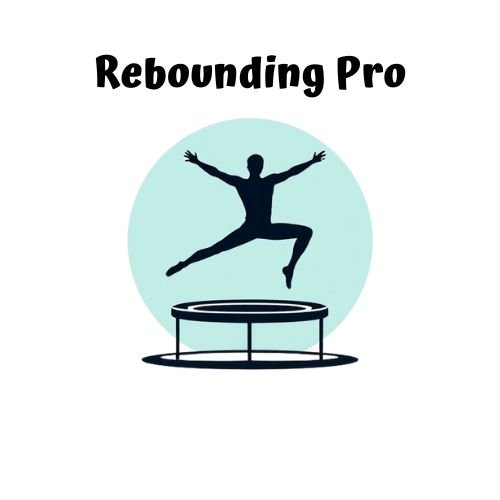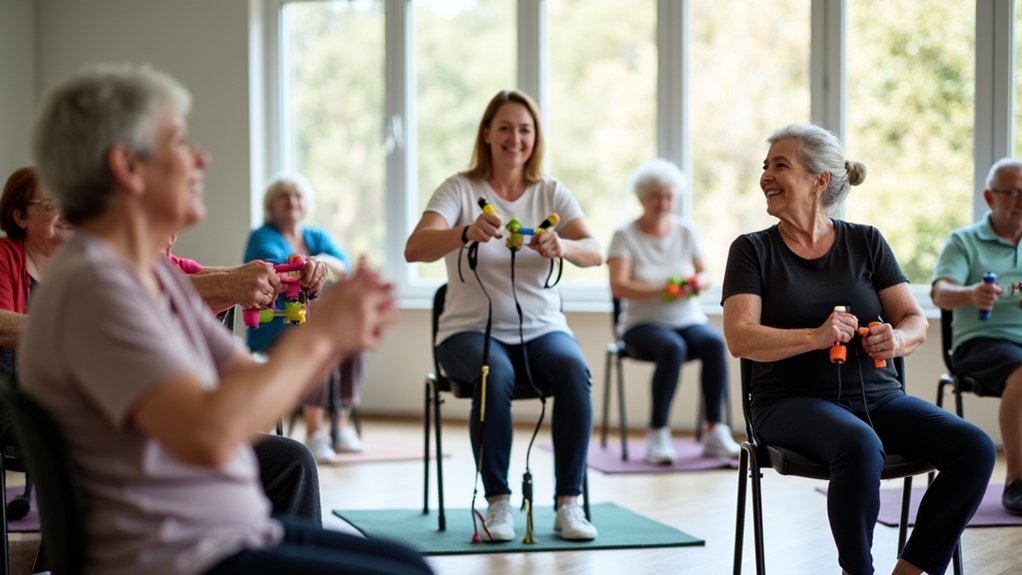Rebounding on a mini-trampoline for just 10 minutes can notably reduce your stress levels. The rhythmic bouncing lowers cortisol, triggers endorphin release, and improves circulation while helping you disconnect from daily pressures. Try mini-jumps for 30 seconds, rhythm bounces for 1-2 minutes, or playful side-to-side hops to instantly shift your emotional state. You can even synchronize your breathing—inhale while rising, exhale when landing—for enhanced calm. These simple techniques offer powerful relief within moments.
The Science Behind Rebounding and Stress Reduction

While many exercise methods claim to reduce stress, rebounding stands out for its scientifically proven effectiveness. When you jump on a mini-trampoline, your body immediately begins to lower cortisol levels while triggering endorphin production—nature’s mood enhancers.
Just 10 minutes is enough to feel the gentle impact that elevates your heart rate and improves circulation, directly combating anxiety. The rhythmic bouncing naturally creates a mindful state, helping you disconnect from daily pressures.
What makes rebounding particularly valuable is its accessibility. Regardless of your fitness level, you can engage in this low-impact activity and reap significant mental health benefits.
Regular sessions have been shown to reduce symptoms of anxiety and depression, making this simple exercise a powerful tool for emotional well-being.
Quick Bounce Techniques for Immediate Calm
When stress threatens to overwhelm you, quick bounce techniques can provide almost instant relief.
When life’s pressures mount, a moment of intentional bouncing can instantly reset your nervous system.
These short bursts of movement trigger your body’s natural relaxation response while boosting endorphin levels. You’ll feel your mood lift as blood circulation increases and anxiety diminishes.
Try these simple techniques anywhere, anytime:
- Mini-Jumps – Do 30 seconds of gentle jumping to quickly elevate your heart rate and shift your emotional state.
- Rhythm Bounce – Bounce lightly while standing in place for 1-2 minutes, focusing on the rhythmic movement to enhance your body-mind connection.
- Playful Hops – Incorporate playful side-to-side or forward-backward hops to recapture a sense of joy and spontaneity.
These low-impact movements require no equipment but deliver powerful stress-relieving benefits in just minutes.
Rhythmic Movement Patterns to Release Tension

Expanding from quick bounces, rhythmic movement patterns offer a deeper approach to tension release through sustained, fluid motion. These movements activate your body’s natural relaxation response, effectively dissolving accumulated stress.
| Movement Type | Benefit | Time Needed |
|---|---|---|
| Gentle Swaying | Brain wave synchronization | 2-3 minutes |
| Walking | Endorphin release | 5+ minutes |
| Tai Chi | Mindfulness & focus | 5-10 minutes |
| Yoga Flows | Emotional resilience | 3-7 minutes |
You don’t need extended sessions to reap benefits—just a few minutes of rhythmic movement can greatly improve your mental clarity. These low-impact exercises work by creating rhythmic patterns that help your nervous system downshift from high alert to calm composure, making them perfect tools for managing stress during busy days.
Creating Your Daily Rebounding Routine
Beyond traditional stress-relief exercises, rebounding offers a uniquely effective mini-workout that combines physical benefits with powerful stress-reducing effects.
With just 5-10 minutes daily on a mini-trampoline, you’ll boost circulation while your body releases tension and floods with endorphins.
Establish consistent rebounding times to form a lasting habit that clears your mind and elevates your mood. As you bounce, incorporate deep breathing—inhale as you rise, exhale as you land—to maximize relaxation benefits.
To create an engaging routine:
- Start with gentle bouncing in place to warm up your body
- Mix in side-to-side movements to engage different muscle groups
- Add modified jumping jacks to increase circulation and lymphatic flow
Keep your routine fresh by rotating through these movements daily.
Mindful Jumping: Combining Breath and Movement

The profound connection between your breath and movement creates a powerful foundation for stress relief through mindful jumping. As you establish a rhythm, synchronize your breathing—inhale deeply while rising and exhale fully upon landing. This intentional pairing calms your nervous system almost immediately.
You’ll notice an uplift in your mood as endorphins flood your system, naturally reducing anxiety with each jump. The beauty of this practice lies in its simplicity; you don’t need special equipment or extended time commitments to experience benefits.
Try incorporating mindful jumping into your daily schedule during short breaks. Even just a minute or two strengthens your body-mind connection, making you more resilient when facing stressful situations.
This portable practice becomes a valuable tool for managing tension wherever life takes you.
Frequently Asked Questions
What Is the Best Exercise for Stress Relief?
You’ll find yoga most effective for stress relief. It combines movement with deep breathing, boosting endorphins while strengthening your mind-body connection. Even short sessions can reduce anxiety and improve your mental clarity.
Is Jumping on a Mini Trampoline Good for You?
Yes, mini trampoline jumping is excellent for you. You’ll strengthen muscles, burn calories efficiently, enjoy low-impact exercise that’s gentle on joints, boost your lymphatic system, and release mood-enhancing endorphins that reduce stress and anxiety.
What Are the Movement Exercises for Mental Health?
You’ll find yoga, tai chi, walking, dancing, and gentle stretching effective for mental health. These movements reduce anxiety, improve focus, and boost your mood when practiced consistently. Mini-trampolining can also release endorphins and reduce stress.
How Can Cardiorespiratory Exercises Help Manage Stress?
Cardiorespiratory exercises help you manage stress by releasing endorphins, improving sleep quality, and enhancing oxygen flow. When you run or cycle regularly, you’ll experience reduced anxiety symptoms and develop mindfulness through rhythmic movement patterns.
In Summary
You’ve now discovered the simple power of rebounding to transform your stress. Remember, it only takes a few minutes on your mini-trampoline to shift your mood and physiology. Make these quick bounces part of your daily routine, and you’ll notice the difference in your overall well-being. When tension rises, don’t overthink it—just jump it out. Your body and mind will thank you.





Leave a Reply